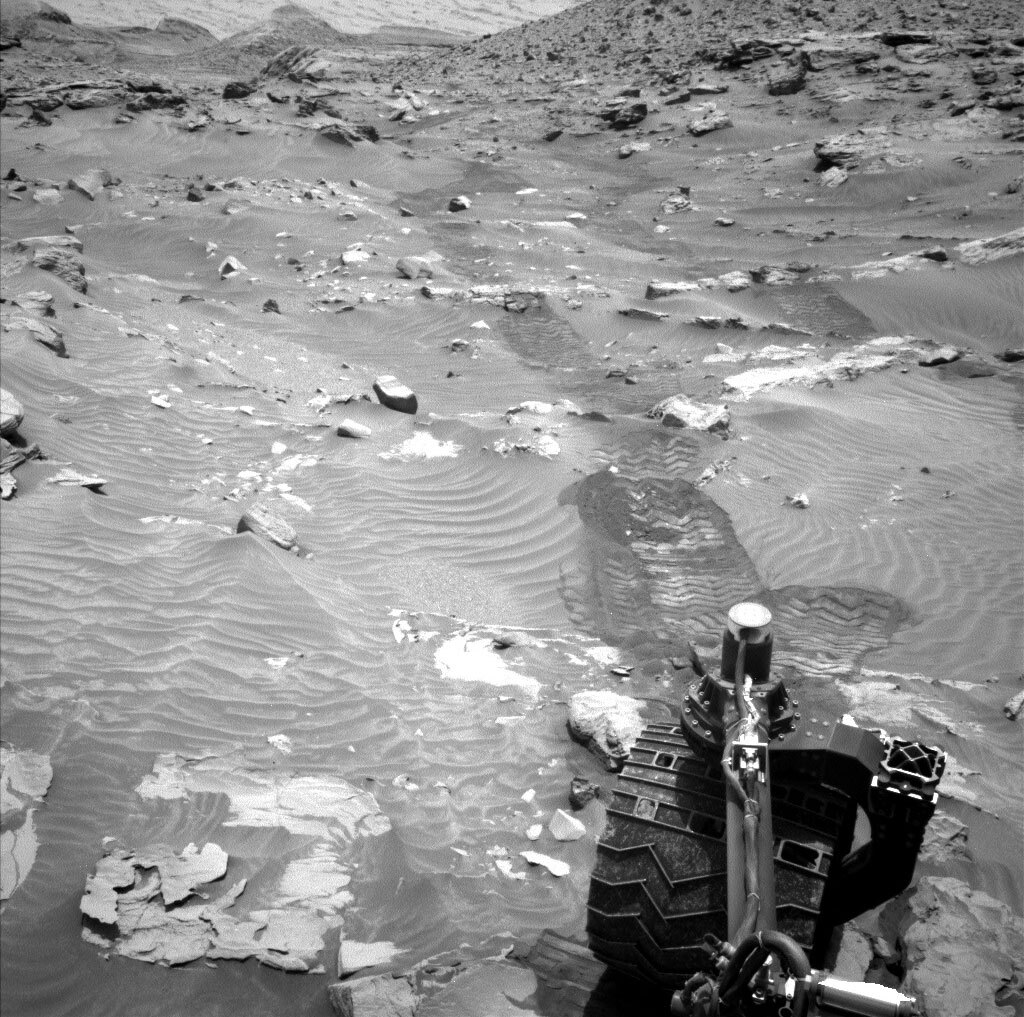5 min read

We are continuing to slowly move through this very challenging terrain – over the weekend we made it about 4 meters before the drive stopped when the rover sensed more difficulty. The attached image shows the deeper rover tracks over the undulating and rocky terrain, which has given us so much trouble driving and making it frequently unsafe to unstow the arm.
Despite all the challenges, this was a very exciting day for the MSL team. In honor of international Women’s day (3/8/22) we fielded a team consisting almost entirely of women. We had more than 35 women participating in planning today, between uplink and downlink. Most of the names and roles are included below.
Our first challenge today was dealing with the drive stopping early, in a place that we didn’t expect. Given the difficulties of driving in this area, this was not a huge surprise. With the rover not being in the expected orientation, Curiosity would not have been able to see Earth to receive this plan (the line of site was again occluded by the terrain). Instead, we ended up relaying the plan via the TGO orbiter. Due the timing of the relay, we shifted our plan to cover sols 3409-3410 instead of 3408-3409. Once we knew we could get the plan to the rover, we were able to move forward with the day. We won’t see the results of this plan until Friday morning, but that gives us more time in our plan for targeted observations on the first sol and allows us to drive on the second sol.
In the morning of the first sol, ChemCam did a LIBS observation of “Achvarasdal,” a dark toned target in our workspace, and a 10-frame long-distance RMI mosaic of the Gediz Vallis Ridge. We also took several Mastcam mosaics, including the ChemCam targets as well as a large 16-frame mosaic to look at pebble sorting and an extension of our prior drive direction imaging. All of these Mastcam images will hopefully provide a 3-D reconstruction of the formations in this area, which can tell us something about how the materials were deposited.
Unlike our previous drive faults, we ended in a place that we could safely unstow the arm for contact science. The target named “Skaw Granite” is one of the larger pieces of bedrock within reach. With the extra time, the arm Rover Planners were able to incorporate a brush of the contact science target (for which we did not have time in the original plan). We also could move the arm backbone later, which allowed for better lighting of the MAHLI images and better temperatures for APXS.
The mobility Rover Planners had a big task – to figure out how to continue to make progress in this very challenging spot. They ended up putting in a lot of extra safety checks and some conditional sequencing in order to try to account for many different possibilities. We’re trying to follow the same route we have planned before, which should take us along this valley to where we might be able to view the pediment and better assess the safety of driving there, as well as to find a good place to climb up. Hopefully, when we get the results of the drive, this tricky area will be in our rear view mirror. After the drive, we also did a lot of environmental observations with Navcam, including a lot of movies/surveys for dust devils.
Trying to help coordinate and hande all of these different complications, while completing planning on time, definitely kept my hands full today as the Tactical Uplink Lead. We really took our time to sort things out and get things right, which did make for a slow start to the planning day, but we got everything in the plan and did complete our process without going too late.
Women Planning Team
Elena Amador-French (JPL, Science Operations Coordinator)
Aseel Anabtawi (JPL, Strategic Comm)
Taryn Aranador (JPL, Enginering Cameras Uplink)
Keri Bean (JPL, Rover Planner)
Diana Blaney (JPL, Science Operations Working Group Chair)
Anna Boettcher (JPL, Sample Acquisition and Sample Processing and Handling)
Nataly Brandt (JPL, Thermal)
Lea Chandler (JPL, Tactical Downlink Lead)
Monika Danos (JPL, Telecom)
Charlene Doucet (Centre National D’etudes Spatiales, France, ChemCam)
Deirdra Fey (Malin Space Science Systems, MAHLI/MARDI)
Amy Hale (JPL, Rover Planner)
Jennifer Herman (JPL, Power Lead)
Alexandra Holloway (JPL, Data Management)
Madison Hughes (Washington University, St. Louis, Surface Properties Scientist)
Heather Lethcoe (JPL, Operations Products Generation Subsystem Tactical Analyst)
Morgan Lewis (University of Tennessee Knoxville, MAHLI/MARDI)
Megan Lin (JPL, Mission Lead)
Sophia Mitchell (JPL, Rover Planner)
Natalie Moore (Malin Space Science Systems, Mastcam)
Valerie Mousset ((Centre National D’etudes Spatiales, France, ChemCam)
Emily Newman (JPL, Strategic Rover Planner)
Catherine O'Connell-Cooper (University of New Brunswick, Canada, APXS)
Lara Panossian (JPL, Science Planner)
Deborah Padgett (JPL, Engineering Cameras Downlink)
Betina Pavri (JPL, Payload Downlink Coordinator)
Kristin Rammelkamp – (L'Institut de Recherche en Astrophysique et Planétologie, France, ChemCam)
Jackie Rapinchuk (JPL, Power)
Nicky Relatores (JPL, Sequence Integration Engineer)
Kimberly Rink (JPL, Mobility/Mechanisms)
Carolina Rodriguez Sanchez-Vahamonde (Malin Space Science Systems, Data Management and MARDI)
Ashley Stroupe (JPL, Tactical Uplink Lead)
Lucy Thompson (University of New Brunswick, Canada, APXS)
Kathryn Tzekof (JPL, Supratactical Uplink Lead)
Nancy Vandermey (JPL, Sequence Integration Engineer)
Trinh Vo (JPL, Operations Products Generation Subsystem Pipeline)
Emme Wiederhold (JPL, Engineering Uplink Lead)
Katherine Winchell (Malin Space Science Systems, MAHLI/MARDI)
Written by Ashley Stroupe, Mission Operations Engineer at NASA's Jet Propulsion Laboratory







